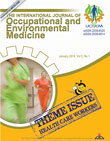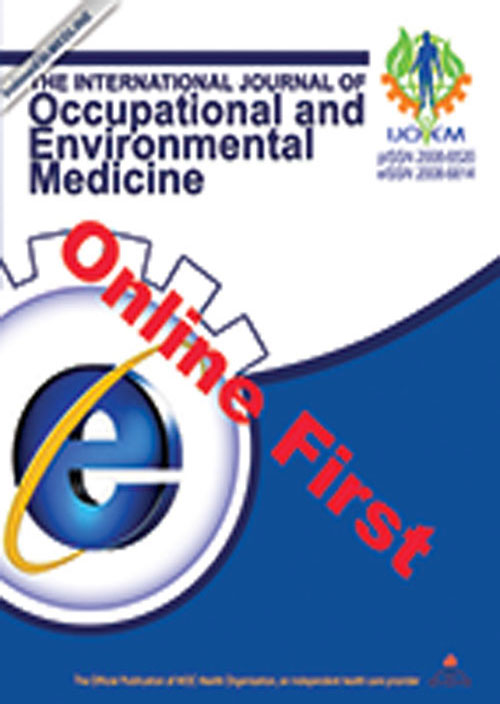فهرست مطالب

International Journal of Occupational and Environmental Medicine
Volume:5 Issue: 1, Jan 2014
- تاریخ انتشار: 1392/11/19
- تعداد عناوین: 8
-
-
Needle-Stick Injury among Health Care Workers in Hemodialysis Units in Nigeria: A Multi-Center StudyPage 1BackgroundNeedle-stick and sharps injuries carry the risk of infection and are occupational hazards for all health care professionals involved in clinical care.ObjectiveTo determine the frequency and factors contributing to needle-stick injury (NSI) among health care workers of dialysis units in Lagos, Nigeria.MethodsData were obtained by anonymous, self-reporting questionnaire from staff of 4 hemodialysis units between October and December 2011. Information on demographics, job category and duration, details of NSI in the past, kind of activity and procedure under which the NSI occurred, if injury was reported, vaccination status of staff, and post-exposure treatment received were obtained.ResultsThe study population included 38 (37.3%) doctors, 42 nurses (41.2%), 14 (13.7%) dialysis technicians and 8 (7.8%) ancillary staff. There were 39 (38.2%) males. The mean±SD age of the study population was 34.4±8.3 years. 25 (24.5%) staff had suffered NSI in the last 12 months and 41 (40.2%) in their entire working career. The most common activity leading to NSI was recapping of needles (45%), improper disposal of needles (30%), and venous cannulation and setting of drips (27.5%). NSI was significantly (p=0.016) higher among those with work experience between 6 and 10 years than others. Hollow bore needles were responsible for 82.9% of the NSIs. Only 15 (37%) respondents reported their NSI to their unit head or designated officer in order to get medical advice.ConclusionIn Lagos, Nigeria, NSI is common among hemodialysis staff and is under-reported. Many NSIs can be prevented by adhering to the practice of universal precautions as well as education of staff on such precautionary methods.
-
Page 9BackgroundCurrent WHO best infection control practices for injections do not address the use of hub cutters due to insufficient evidence on safety and efficacy.ObjectiveTo assess the impact of the use of hub cutters on 1) the frequency of needle-stick injuries (NSIs) and other blood exposures among workers and 2) the volume of sharps waste in a mass vaccination campaign setting.MethodsDuring yellow fever vaccination in Ghana, we conducted a cohort study on the use of hub cutters. We compared two groups—one group using hub cutters and a control group—for the occurrences of NSIs and the volume of sharp waste produced.ResultsIn the control arm, vaccinators used 284 482 syringes in 825 vaccination sessions. In the group using hub cutter, vaccinators used 397 079 syringes in 1599 sessions. Among vaccinators, the rate of NSI was not significantly (p=0.14) different between the hub cutter users (0.15/10 000 syringes) and the control group (0.04/10 000). Factors such as workload, lack of organization and pressure seemed to have influence the occurrence of NSIs. With all the limitations of the work, the volume of sharp waste per 10 000 syringes was 0.24 m3 in the hub cutter users and 0.41 m3 in the control group—a reduction of 41.2%. Vaccinators found hub cutters easy to use and safe. Use of hub cutter was not associated with increased duration of work.ConclusionThe use of hub cutters did not increase the risk of NSIs. More training is needed to facilitate its implementation in mass campaign setting.
-
Page 18BackgroundDental waste can be hazardous to humans and the environment.ObjectiveTo determine the current status of dental waste management in private and public dental clinics and private dental offices in Shiraz, southern Iran.MethodsThis cross-sectional study was conducted at the Shiraz University of Medical Sciences from February through June 2013. A stratified random sampling method was used to study 86 private offices, 14 private clinics and 10 public clinics. Types of waste studied included mercury and amalgam, lead foil packets, sharps, infectious tissues and fluids, pharmaceuticals and domestic waste materials. Compliance with established standards by the monitored dental offices and clinics and public clinics were compared.Results89.1% of dental offices and clinics disposed their infectious waste with domestic waste. Only 60% of centers used standard method for sharps disposal. None of the dental centers disposed their pharmaceutical waste and x-ray fixer waste by standard methods. Less than 10% of centers recycled the amalgam and lead foil pockets waste to the manufacture.ConclusionGovernment agencies should establish monitoring programs for all dental offices and clinics to identify noncompliant activity and enforce recommended regulations.
-
Page 24BackgroundIn recent years, dentists have more opportunity of treating patients infected with blood-borne pathogens. Although compliance with infection control practice (ICP) in dental practice is required, it is not still sufficiently spread in Japan.ObjectiveTo identify factors associated with compliance with ICPs in the population of Japanese dentists.MethodsIn a questionnaire-based cross-sectional study in 2009, 2134 dentists in Aichi prefecture, Japan, were surveyed. They were asked for their demographic characteristics, willingness to treat HIV/AIDS patients, and knowledge about universal/standard precautions and ICP.ResultsMany ICP items had significant association with age, specialty for oral surgery, number of patients treated per day, willingness to treat HIV/AIDS patients and knowledge about the universal/standard precautions. In logistic regression model, knowledge about the precautions had significant associations with all ICP items. Among participants with disadvantageous characteristic group for ICP (ie, age ≥50 years, being general dentist, and treating ≤35 patients/day), knowledge about the universal/standard precautions had greater impact on exchanging handpiece for each patient and installing extra-oral vacuum in those with age of ≥50 years than in those who visited ≤35 patient per day.ConclusionKnowledge about the meaning of universal/standard precautions is the most significant predictor of compliance with ICPs among Japanese dentists.
-
Page 32BackgroundExposure to human blood and body fluids is a common risk for nurses. Many factors can affect the prevalence and incidence of this occupational hazard. Psychosocial factors at work may be a risk factor for the exposure.ObjectiveTo assess needle stick, sharp injury and mucus exposure to blood-borne pathogens among nurses in Iran and to determine the association between these exposures and psychosocial factors at work.MethodsA cross-sectional study was conducted on nurses in a public hospital, Tehran, Iran. 364 nurses received and 339 completed and returned a self-reported questionnaire containing demographic data, history of exposure to blood-borne pathogens at work during previous year and the General Nordic questionnaire for psychological and social factors at work (QPS Nordic 34+ Questionnaire).ResultsOf 339 participants, 197 (58.1%) reported needle-stick injury, 186 (54.6%) reported another type of sharp injury, and 112 (33%) reported a mucous membrane exposure during the previous year. More than half of the participants who had history of exposure, had not reported it. Those with middle or high level of stress had higher crude and adjusted odds than those with lower stress for all kinds of exposure. Adjusted odds ratios for high stress group (ranging from 2.8 to 4.4) were statistically different from 1.ConclusionThere is a high prevalence of needle-stick and sharp injury and mucous membrane exposure to patients'' blood or body fluids among studied nurses. There is a significant association between increasing psychosocial factors at work and exposure to blood-borne pathogens among this group of nurses.
-
Page 40BackgroundThe guidelines for minimizing occupational health risk from exposure to highly infectious diseases is already established but little information exists on the compliance of these measures among paramedical workers in India.ObjectiveTo study the awareness of occupational safety measures such as universal precautions, biomedical waste handling, disposal and its compliance in their daily practice.MethodsA hospital-based cross-sectional study was undertaken in a tertiary private hospital in Karnataka, Bangalore, India. Data was collected using a pretested and predesigned proforma from 120 respondents: 85 nurses and 35 laboratory technicians.Results27 (32%) nurses and 20 (57%) laboratory technicians could relate universal precautions to infection prevention. Only 6 (7%) nurses and 2 (6%) technicians had knowledge about proper hospital waste segregation. 45 (52.9%) nurses and 15 (42.8%) technicians had knowledge about post-exposure prophylaxis. 3 (4%) nurses and 9 (26%) technicians were formally trained in following universal precautions. Adequate hand washing was practiced among 17 (20%) nurses and none of the technicians. Faulty practice such as recapping of needle was prevalent among 57 (67%) nurses and 29 (83%) technicians. 32 (38%) nurses and 10 (29%) technicians received hepatitis B vaccine.ConclusionAs knowledge and practice regarding different aspects of universal precautions was not satisfactory, training was warranted urgently in the study population. Also, suggestions were made to develop and implement institutional policies on the universal precautions and ensuring supply of personal protection equipment.
-
Page 51BackgroundHepatitis B virus (HBV) infection is an endemic infection in Nigeria. Health care workers (HCWs) are at risk of occupational exposures to HBV-infected blood and body fluids.ObjectiveTo determine the prevalence and determinants of HBV vaccine coverage among HCWs in two teaching hospitals in Nigeria.MethodsThis cross-sectional study was undertaken in 2011 and 2012 in two teaching hospitals in Jos, North-Central Nigeria, and Yenagoa, South-South Nigeria. A self-administered structured questionnaire was administered to HCWs to obtain socio-demographic data and history of HBV vaccination.ResultsOut of 290 HCWs who participated in the study, 185 (64.5%) had received at least one dose of HBV vaccine; 105 (36.2%) had full coverage of three doses. Professional category and previous training in infection control were independently associated with HBV vaccination. House officers and laboratory scientists were more likely to be unvaccinated than resident doctors, consultant doctors and nurses. Full vaccine coverage was associated with younger age and shorter years of professional experience.ConclusionWe observed a generally low rate of HBV vaccine coverage among HCWs in Nigeria. Establishment of policies on compulsory HBV vaccination of all HCWs in Nigeria is recommended.
-
Page 57Blood and body fluid Exposure is a major occupational safety problems for health care workers. Therefore, we conducted a descriptive and retrospective study to identify the characteristics of blood exposure accidents in health care settings which lasted five years (2005-2009) at the two university hospitals of Sfax. We have 593 blood exposure accidents in health care settings 152 (25.6%) health personnel and 441 (74.4%) trainees'' doctors, nurses and health technicians. The mechanism of blood and body fluid exposure was accidental needle-stick injury in 78.9% of health staff, and 81% of trainees, accidental cut in 14.7% of health workers and 10.2% of trainees. The increasing severity of blood exposure accidents is linked to the lack of safe behavior against this risk.


